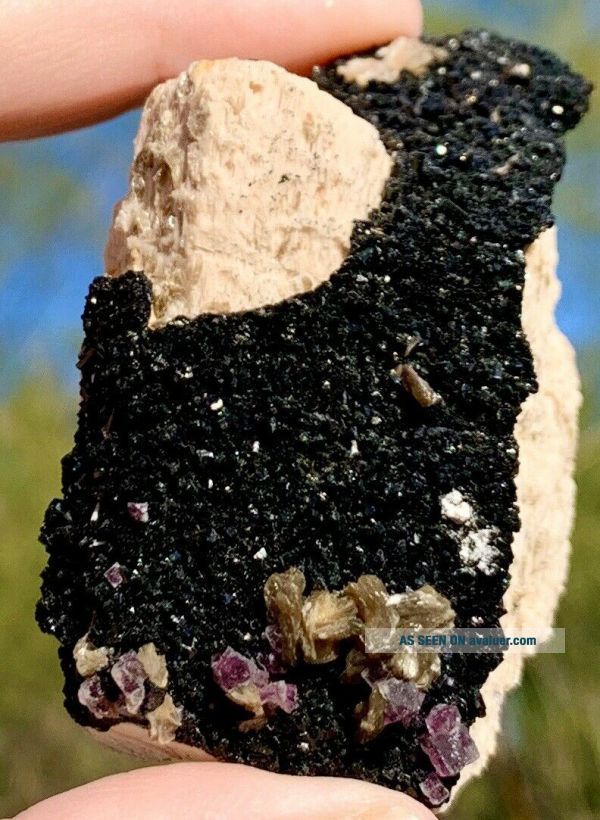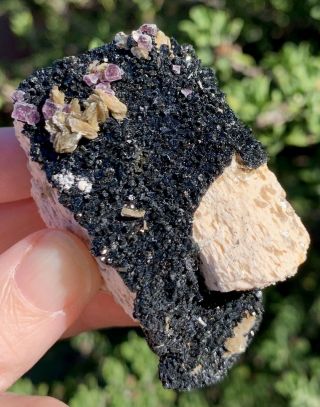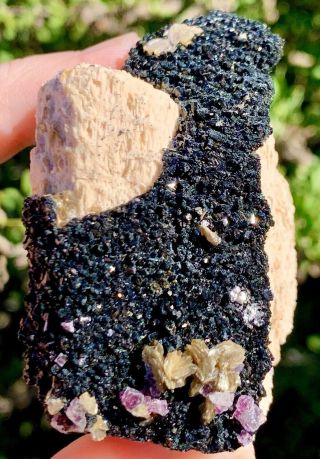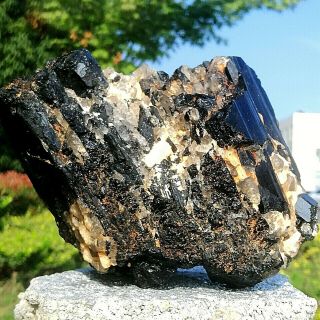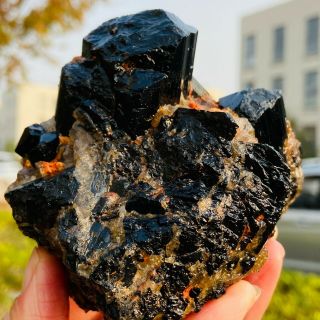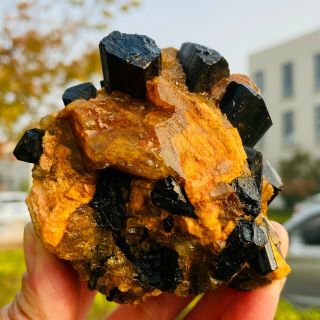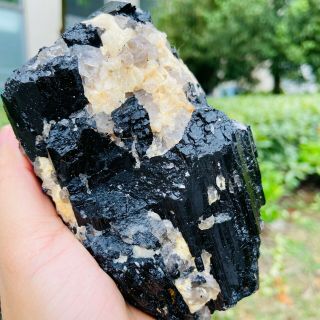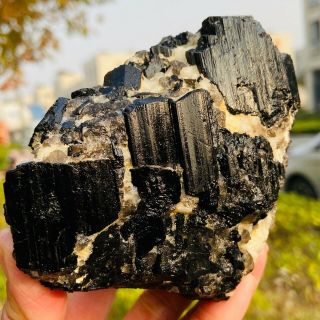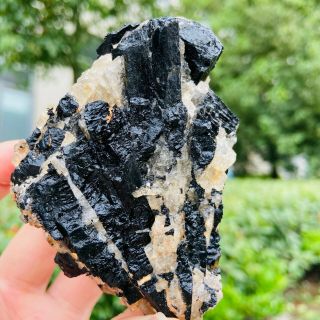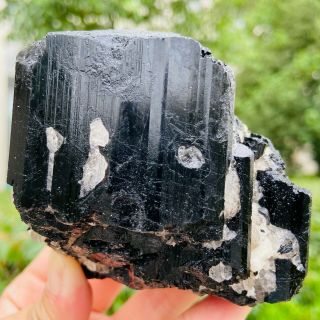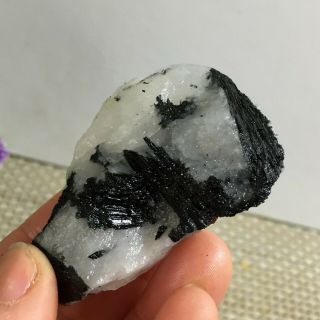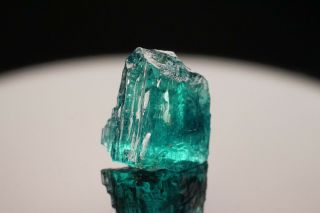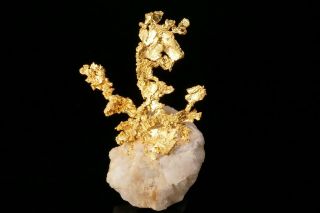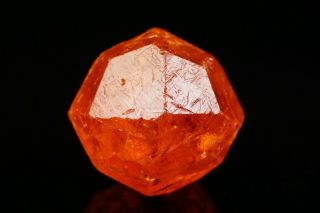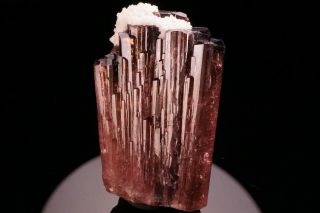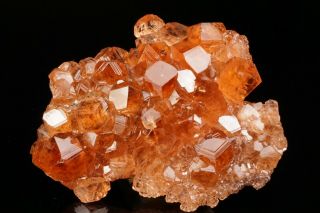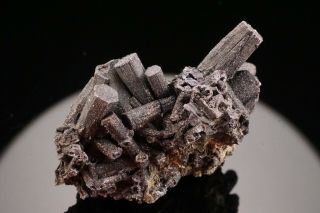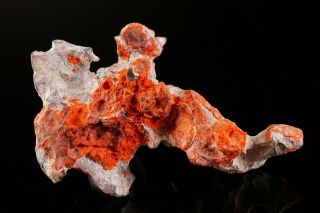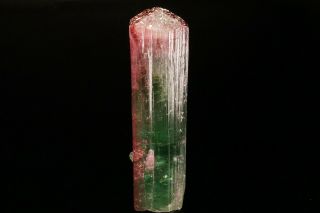RARE Black Tourmaline Aquamarine Crystal Cluster Mineral Specimen Fluorite Gem
Item History & Price
I offer a shipping discount for customers who combine their payments for multiple purchases into one payment!The discount is regular shipping price for the first item and just 50 cents for each additional item!To be sure you get your shipping discount just make... sure all the items you want to purchase are in your cart.Auctions you win are added to your cart automatically.For any "buy it now" items or second chance offers, be sure to click the "add to cart" button, NOT the "buy it now" button.Once all of your items are in your cart just pay for them from your cart and the combined shipping discount should be applied automatically.
I offer a money back guarantee on every item I sell.If you are not 100% happy with your purchase just send me a message to let me knowand I will buy back the item for your full purchase price.
Hi there. I am selling this A ++ High grade crystal cluster mineral specimen with AMAZING Black Tourmaline as well as aquamarine crystals, I see that there is also a white matrix that I believe is potentially feldspar in this specimen as well. This particular piece also has some mica crystals as well as some small purple fluorite crystals on it too. I purchased an entire collection of these specimen and the box said “various mineral specimens” - I know - so helpful right? So some of this is a guess, like feldspar.
This gorgeous cluster is from Erongo Massif, Omaruru District, Eringo Region, Namibia, Africa.
If you have any questions, do not hesitate to ask me. Thanks so much for visiting my listings and have a great day!
The following is information about tourmaline and aquamarine crystals from wikipedia:
Aquamarine gemstones evoke the colors of the sea. Aquamarine can be blue, very slightly greenish blue, greenish blue, very strongly greenish blue, or green-blue.
Aquamarine gemstones are often free from inclusions and clear as water too, symbolizing purity of spirit and soul. They make fantastic gemstones for evening wear because they glitter and gleam even under muted light conditions. During the day or in bright light, they exhibit a soothing coolness. Aquamarines are found on most continents.
Aquamarine is the March birthstone, but anyone can wear and delight in the optical qualities of this gemstone.
Aquamarine Facts:
Aquamarine belongs to the beryl species of mineral and is closely related to emerald, morganite and golden beryl, among others.
Brazil is an important source for aquamarine. Other sources include Afghanistan, Burma (Myanmar), China, Kenya, Madagascar, Mozambique, Ukraine and the United States.
Aquamarine is a fairly durable gemstone with a hardness of 7.5-8.0 on the Mohs Hardness Scale. Aquamarine gemstones can be cut into many shapes and sizes. Some are cut as cabochons or fashioned into beads. Larger specimens may be carved into gem sculptures.
Nature produces a variety known as cat’s-eye aquamarine, a rare, highly collectible, phenomenal variety. Microscopic growth tube inclusions cause the cat’s-eye effect.
Tourmaline gemstones come in almost every color of the rainbow. The most popular tourmaline varieties range from rich reds, pinks and peach colors, to emerald greens and yellows, to blues and violets.Black and brown tourmalines are also used in jewelry. Not surprisingly, this gemstone’s name is derived from the Sinhalese word “toromalli, ” which means mixed gems. While it can look like many other materials, tourmaline stands on its own as one of the world’s most popular gems. Tourmaline comes from many places around the world and is a gemstone everyone can enjoy. It is one of the October birthstones, but those born in other months also take pleasure from its beauty.
Tourmaline Facts:
Brazil is one of the world’s main sources of tourmaline. Others include Afghanistan, Kenya, Madagascar, Mozambique, Namibia, Nigeria, Pakistan, Russia, Sri Lanka, Tanzania, the United States and Zambia. Tourmaline is a fairly durable gemstone with a hardness of 7.0-7.5 on the Mohs Hardness Scale. Tourmaline gemstones can be cut into many shapes and sizes, often as faceted gems, cabochons, polished crystal slices or mineral specimens. Cutters often fashion tourmalines as long rectangles. “Parti-colored” tourmalines exhibit two or more colors in a single gem, such as watermelon and liddicoatite tourmaline. “Bicolor” tourmaline displays two distinct color zones. Paraíba tourmaline, named after the place where it was first found in Brazil, is a trade term for vividly saturated green to blue or violet copper-bearing elbaite tourmaline. Rubellite refers to pink to red elbaite tourmaline. Indicolite refers to the blue variety. Chrome tourmaline is a trade term for vibrant green tourmaline.
TourmalineFrom Wikipedia, the free encyclopedia
Crystal system TrigonalCrystal class Ditrigonal pyramidal (3m)H-M symbol: (3m)IdentificationColor Most commonly black, but can range from colorless to brown, red, orange, yellow, green, blue, violet, pink, or hues in between; can be bi-colored, or even tri-colored; rarely can be neon green or electric blueCrystal habit Parallel and elongated. Acicular prisms, sometimes radiating. Massive. Scattered grains (in granite).Cleavage IndistinctFracture Uneven, small conchoidal, brittleTenacity brittleMohs scale hardness 7–7.5Red Tourmaline: Definite; dark red, light redGreen Tourmaline: Strong; dark green, yellow-greenBrown Tourmaline: Definite; dark brown, light brownBlue Tourmaline: Strong; dark blue, light blueDispersion .017[1]Ultraviolet fluorescence pink stones—inert to very weak red to violet in long and short wave[1]
Tourmaline ( /ˈtʊərməliːn/ TOOR-mə-leen) is a crystalline boron silicate mineral compounded with elements such as aluminium, iron, magnesium, sodium, lithium, or potassium. Tourmaline is classified as a semi-precious stone and the gemstone comes in a wide variety of colors.
EtymologyAccording to the Madras Tamil Lexicon[3] the name comes from the Sinhalese word "thoramalli" (තෝරමල්ලි) or "tōra- molli", which is applied to a group of gemstones found in Sri Lanka. According to the same source, the Tamil "tuvara-malli" (துவரைமல்லி) and "toramalli" are also derived from the Sinhalese root word. This etymology is also given in other standard dictionaries including the Oxford English Dictionary.
HistoryBrightly colored Sri Lankan gem tourmalines were brought to Europe in great quantities by the Dutch East India Company to satisfy a demand for curiosities and gems. At the time, [when?] it was not realised that schorl and tourmaline were the same mineral, as it was only about 1703 that it was discovered that some colored gems were not zircons.[citation needed] Tourmaline was sometimes called the "Ceylonese [Sri Lankan] Magnet" because it could attract and then repel hot ashes due to its pyroelectric properties.[2][4]
Tourmalines were used by chemists in the 19th century to polarize light by shining rays onto a cut and polished surface of the gem.[5]
Species and varietiesCommonly encountered species and varieties:
Schorl species:
Brownish black to black—schorl, Dravite species: from the Drave district of Carinthia
Dark yellow to brownish black—dravite, Elbaite species: named after the island of Elba, Italy
Red or pinkish-red—rubellite variety, Light blue to bluish green—Brazilian indicolite variety (from indigo), Green—verdelite or Brazilian emerald variety, Colorless—achroite variety (from the Greek "άχρωμος" meaning "colorless").Schorl
A single stark green fluorite isolated on top of schorl crystalsThe most common species of tourmaline is schorl, the sodium iron (divalent) endmember of the group. It may account for 95% or more of all tourmaline in nature. The early history of the mineral schorl shows that the name "schorl" was in use prior to 1400 because a village known today as Zschorlau (in Saxony, Germany) was then named "Schorl" (or minor variants of this name), and the village had a nearby tin mine where, in addition to cassiterite, black tourmaline was found. The first description of schorl with the name "schürl" and its occurrence (various tin mines in the Saxony Ore Mountains) was written by Johannes Mathesius (1504–1565) in 1562 under the title "Sarepta oder Bergpostill".[6] Up to about 1600, additional names used in the German language were "Schurel", "Schörle", and "Schurl". Beginning in the 18th century, the name Schörl was mainly used in the German-speaking area. In English, the names shorl and shirl were used in the 18th century. In the 19th century the names common schorl, schörl, schorl and iron tourmaline were the English words used for this mineral.[6]
Dravite
Black dravite on a grey matrixDravite, also called brown tourmaline, is the sodium magnesium rich tourmaline endmember. Uvite, in comparison, is a calcium magnesium tourmaline. Dravite forms multiple series, with other tourmaline members, including schorl and elbaite.
The name dravite was used for the first time by Gustav Tschermak (1836–1927), Professor of Mineralogy and Petrography at the University of Vienna, in his book Lehrbuch der Mineralogie (published in 1884) for magnesium-rich (and sodium-rich) tourmaline from village Dobrova near Unterdrauburg in the Drava river area, Carinthia, Austro-Hungarian Empire. Today this tourmaline locality (type locality for dravite) at Dobrova (near Dravograd), is a part of the Republic of Slovenia.[7] Tschermak gave this tourmaline the name dravite, for the Drava river area, which is the district along the Drava River (in German: Drau, in Latin: Drave) in Austria and Slovenia. The chemical composition which was given by Tschermak in 1884 for this dravite approximately corresponds to the formula NaMg3(Al, Mg)6B3Si6O27(OH), which is in good agreement (except for the OH content) with the endmember formula of dravite as known today.[7]
Dravite varieties include the deep green chromium dravite and the vanadium dravite.
Elbaite
Elbaite with quartz and lepidolite on cleavelanditeA lithium-tourmaline elbaite was one of three pegmatitic minerals from Utö, Sweden, in which the new alkali element lithium (Li) was determined in 1818 by Johan August Arfwedson for the first time.[8] Elba Island, Italy, was one of the first localities where colored and colorless Li-tourmalines were extensively chemically analysed. In 1850 Karl Friedrich August Rammelsberg described fluorine (F) in tourmaline for the first time. In 1870 he proved that all varieties of tourmaline contain chemically bound water. In 1889 Scharitzer proposed the substitution of (OH) by F in red Li-tourmaline from Sušice, Czech Republic. In 1914 Vladimir Vernadsky proposed the name Elbait for lithium-, sodium-, and aluminum-rich tourmaline from Elba Island, Italy, with the simplified formula (Li, Na)HAl6B2Si4O21.[8] Most likely the type material for elbaite was found at Fonte del Prete, San Piero in Campo, Campo nell'Elba, Elba Island, Province of Livorno, Tuscany, Italy.[8] In 1933 Winchell published an updated formula for elbaite.
Tourmaline is a six-member ring cyclosilicate having a trigonal crystal system. It occurs as long, slender to thick prismatic and columnar crystals that are usually triangular in cross-section, often with curved striated faces. The style of termination at the ends of crystals is sometimes asymmetrical, called hemimorphism. Small slender prismatic crystals are common in a fine-grained granite called aplite, often forming radial daisy-like patterns. Tourmaline is distinguished by its three-sided prisms; no other common mineral has three sides. Prisms faces often have heavy vertical striations that produce a rounded triangular effect. Tourmaline is rarely perfectly euhedral. An exception was the fine dravite tourmalines of Yinnietharra, in western Australia. The deposit was discovered in the 1970s, but is now exhausted. All hemimorphic crystals are piezoelectric, and are often pyroelectric as well.
Color
Tourmaline gemstones – MozambiqueTourmaline has a variety of colors. Usually, iron-rich tourmalines are black to bluish-black to deep brown, while magnesium-rich varieties are brown to yellow, and lithium-rich tourmalines are almost any color: blue, green, red, yellow, pink, etc. Rarely, it is colorless. Bi-colored and multicolored crystals are common, reflecting variations of fluid chemistry during crystallization. Crystals may be green at one end and pink at the other, or green on the outside and pink inside; this type is called watermelon tourmaline. Some forms of tourmaline are dichroic, in that they change color when viewed from different directions.
Two dark green rectangular tourmaline stones and one oval tourmaline stone.The pink color of tourmalines from many localities is the result of prolonged natural irradiation. During their growth, these tourmaline crystals incorporated Mn2+ and were initially very pale. Due to natural gamma ray exposure from radioactive decay of 40K in their granitic environment, gradual formation of Mn3+ ions occurs, which is responsible for the deepening of the pink to red color.[13]
MagnetismOpaque black schorl and yellow tsilaisite are idiochromatic tourmaline species that have high magnetic susceptibilities due to high concentrations of iron and manganese respectively. Most gem-quality tourmalines are of the elbaite species. Elbaite tourmalines are allochromatic, deriving most of their color and magnetic susceptibility from schorl (which imparts iron) and tsilaisite (which imparts manganese).
Red and pink tourmalines have the lowest magnetic susceptibilities among the elbaites, while tourmalines with bright yellow, green and blue colors are the most magnetic elbaites. Dravite species such as green chromium dravite and brown dravite are diamagnetic. A handheld neodymium magnet can be used to identify or separate some types of tourmaline gems from others. For example, blue indicolite tourmaline is the only blue gemstone of any kind that will show a drag response when a neodymium magnet is applied. Any blue tourmaline that is diamagnetic can be identified as paraiba tourmaline colored by copper in contrast to magnetic blue tourmaline colored by iron.[14]
TreatmentsSome tourmaline gems, especially pink to red colored stones, are altered by heat treatment to improve their color. Overly dark red stones can be lightened by careful heat treatment. The pink color in manganese-containing near-colorless to pale pink stones can be greatly increased by irradiation with gamma-rays or electron beams. Irradiation is almost impossible to detect in tourmalines, and does not, currently, impact the value. Heavily included tourmalines, such as rubellite and Brazilian paraiba, are sometimes clarity-enhanced. A clarity-enhanced tourmaline (especially the paraiba variety) is worth much less than a non-treated gem.[15]
GeologyTourmaline is found in granite and granite pegmatites and in metamorphic rocks such as schist and marble. Schorl and lithium-rich tourmalines are usually found in granite and granite pegmatite. Magnesium-rich tourmalines, dravites, are generally restricted to schists and marble. Tourmaline is a durable mineral and can be found in minor amounts as grains in sandstone and conglomerate, and is part of the ZTR index for highly weathered sediments.[16]
Localities
Bi-colored tourmaline crystal, 0.8 inches (2 cm) longGem and specimen tourmaline is mined chiefly in Brazil and Africa. Some placer material suitable for gem use comes from Sri Lanka. In addition to Brazil, tourmaline is mined in Tanzania, Nigeria, Kenya, Madagascar, Mozambique, Namibia, Afghanistan, Pakistan, Sri Lanka, and Malawi.[17]
United StatesSome fine gems and specimen material has been produced in the United States, with the first discoveries in 1822, in the state of Maine. California became a large producer of tourmaline in the early 1900s. The Maine deposits tend to produce crystals in raspberry pink-red as well as minty greens. The California deposits are known for bright pinks, as well as bicolors. During the early 1900s, Maine and California were the world's largest producers of gem tourmalines. The Empress Dowager Cixi of China loved pink tourmaline and bought large quantities for gemstones and carvings from the then new Himalaya Mine, located in San Diego County, California.[18] It is not clear when the first tourmaline was found in California. Native Americans have used pink and green tourmaline as funeral gifts for centuries. The first documented case was in 1890 when Charles Russel Orcutt found pink tourmaline at what later became the Stewart Mine at Pala, San Diego County.[19]
Brazil
Watermelon Tourmaline mineral on quartz matrix (crystal approximately 2 cm (0.79 in) wide at face)Almost every color of tourmaline can be found in Brazil, especially in the Brazilian states of Minas Gerais and Bahia. In 1989, miners discovered a unique and brightly colored variety of tourmaline in the state of Paraíba.[citation needed] The new type of tourmaline, which soon became known as paraiba tourmaline, came in blue and green. Brazilian paraiba tourmaline usually contains abundant inclusions. Much of the paraiba tourmaline from Brazil actually comes from the neighboring state of Rio Grande do Norte. Material from Rio Grande do Norte is often somewhat less intense in color, but many fine gems are found there. It was determined that the element copper was important in the coloration of the stone.[20]
World's largestA large cut tourmaline from Paraiba, measuring 36.44 x 33.75 x 21.85 mm (1.43 x 1.33 x 0.86 in) and weighing 191.87 carats, was included in the Guinness World Records.[21] The large natural gem, owned by Billionaire Business Enterprises, [21] is a bluish-green in color. The flawless oval shaped cut stone was presented in Montreal, Quebec, Canada on 14 October 2009.[22]
Africa
Tourmaline mineral, approximately 10 cm (3.9 in) tall.In the late 1990s, copper-containing tourmaline was found in Nigeria. The material was generally paler and less saturated than the Brazilian materials, although the material generally was much less included. A more recent African discovery from Mozambique has also produced tourmaline colored by copper, similar to the Brazilian paraiba. While its colors are somewhat less bright than top Brazilian material, Mozambique paraiba is often less-included and has been found in larger sizes. The Mozambique paraiba material usually is more intensely colored than the Nigerian. There is a significant overlap in color and clarity with Mozambique paraiba and Brazilian paraiba, especially with the material from Rio Grande do Norte. While less expensive than top-quality Brazilian paraiba, some Mozambique material sells for well over $5, 000 per carat, which still is extremely high compared to other tourmalines.
Another highly valuable variety is chrome tourmaline, a rare type of dravite tourmaline from Tanzania. Chrome tourmaline is a rich green color due to the presence of chromium atoms in the crystal; chromium also produces the green color of emeralds. Of the standard elbaite colors, blue indicolite gems are typically the most valuable, [23] followed by green verdelite and pink to red rubellite.[24] There are also yellow tourmalines, sometimes known as canary tourmaline. Zambia is rich in both red and yellow tourmaline, which are relatively inexpensive in that country. The rarest variety, colorless achroite, is not appreciated and is the least expensive of the transparent tourmalines.
AfghanistanIndicolite (blue tourmaline) and verdelite (green tourmaline) are found in the Nuristan region (Ghazi Abad district) and Pech Valley (Pech and Chapa Dara districts) of Kunar province. Gem-quality tourmalines are faceted (cut) from 0.50–10-gram (0.018–0.353 oz) sizes and have high clarity and intense shades of color.
00037



